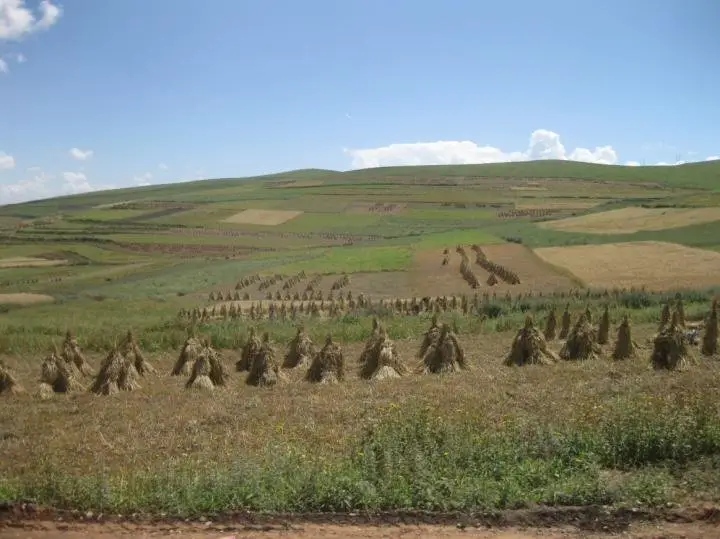Animal teeth, bones and plant remains have helped researchers from Cambridge, China and America to pinpoint a date for what could be the earliest sustained human habitation at high altitude.
Archaeological discoveries from the ‘roof of the world’ on the Tibetan Plateau indicate that from 3,600 years ago, crop growing and the raising of livestock was taking place year-round at hitherto unprecedented altitudes.
The findings, published today in Science, demonstrate that across 53 archaeological sites spanning 800 miles, there is evidence of sustained farming and human habitation between 2,500 metres above sea level (8,200ft) and 3,400 metres (11,154ft).
Evidence of an intermittent human presence on the Tibetan Plateau has been dated to at least 20,000 years ago, with the first semi-permanent villages established only 5,200 years ago. The presence of crops and livestock at the altitudes discovered by researchers indicates a more sustained human presence than is needed to merely hunt game at such heights.

Professor Martin Jones, from Cambridge’s Department of Archaeology, and one of the lead researchers on the project, said: “Until now, when and how humans started to live and farm at such extraordinary heights has remained an open question. Our understanding of sustained habitation above 2-3,000m on the Tibetan Plateau has to date been hampered by the scarcity of archaeological data available.
“But our findings show that not only did these farmer-herders conquer unheard of heights in terms of raising livestock and growing crops like barley and millet, but that human expansion into the higher, colder altitudes took place as the continental temperatures were becoming colder.
“Year-round survival at these altitudes must have led to some very challenging conditions indeed – and this poses further, interesting questions for researchers about the adaptation of humans, livestock and crops to life at such dizzying heights.”
Professor Jones hopes more work will now be undertaken to look at genetic resistance in humans to altitude sickness, and genetic response in crop plants in relation to attributes such as grain vernalisation, flowering time response and ultraviolet radiation tolerance – as well as research into the genetic and ethnic identity of the human communities themselves.
Research on the Tibetan Plateau has also raised interesting questions about the timing and introduction of Western crops such as barley and wheat – staples of the so-called ‘Fertile Crescent’. From 4,000-3,600 years ago, this meeting of east and west led to the joining or displacement of traditional North Chinese crops of broomcorn and foxtail millet. The importation of Western cereals enabled human communities to adapt to the harsher conditions of higher altitudes in the Plateau.
In order to ascertain during what period and at what altitude sustained food produced first enabled an enduring human presence, the research group collected artefacts, animal bones and plant remains from 53 sites across the late Yangshao, Majiayao, Qiija, Xindian, Kayue and Nuomuhong cultures.
Cereal grains (foxtail millet, broomcorn millet, barley and wheat) were identified at all 53 sites and animal bones and teeth (from sheep, cattle and pig) were discovered at ten sites. Of the 53 sites, an earlier group (dating from 5,200-3,600 years ago) reached a maximum elevation of 2,527m while a later group of 29 sites (dating from 3,600-2,300 years ago) approached 3,400m in altitude.
Professor Jones believes the Tibetan Plateau research could have wider and further-reaching implications for today’s world in terms of global food security and the possibilities of rebalancing the ‘global diet’; at present heavily, and perhaps unsustainably, swayed in favour of the big three crops of rice, wheat and maize.
He said: “Our current knowledge of agricultural foods emphasises a relatively small number of crops growing in the intensively managed lowlands. The more we learn about the rich ecology of past and present societies, and the wider range of crops they raised in the world’s more challenging environments, the more options we will have for thinking through food security issues in the future.”
PLEASE SUPPORT OUR CROWDFUNDER ON KICKSTARTER
THE-Heritage Explorer (Magazine)
Support us in launching a printed magazine that explores the history, archaeology, travel, culture and exploration of the world.
THE Heritage Explorer is an exciting print magazine and publishing business proposal dedicated to delivering you the latest exploration, travel, archaeology, culture and heritage news.
A concept born out of the aspirations of a team of journalists, archaeologists and historians to build a credible and sustainable publishing business that will not only provide the public with entertaining articles and up-to-date research, but also to develop career opportunities for all those involved.
This is not just a magazine, but the opportunity for you to plant the seeds for a real contender in the publishing market place. Find out more




